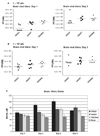Cytokine-modified VSV is attenuated for neural pathology, but is both highly immunogenic and oncolytic
- PMID: 20607123
- PMCID: PMC2895263
- DOI: 10.2147/ijicmr.s6776
Cytokine-modified VSV is attenuated for neural pathology, but is both highly immunogenic and oncolytic
Abstract
Vesicular stomatitis virus (VSV), an enveloped, nonsegmented, negative-stranded RNA virus, is being tested by several laboratories as an antitumor agent. Unfortunately, viral infection of the central nervous system (CNS) has been observed by many groups following administration to tumor-bearing animals. In rodents, VSV encephalitis is characterized by weight-loss, paralysis, and high mortality. In order to provide protection from VSV infection of the CNS after therapeutic administration, we have attenuated VSV by the introduction of the gene encoding the proinflammatory cytokine interleukin (IL)-23, and designated the new virus VSV23. We hypothesize that while VSV23 is replicating within tumors, resulting in tumor destruction, the expression of IL-23 will enhance host antitumor and antiviral immune responses. In the event that the virus escapes from the tumor, the host's immune system will be activated and the virus will be rapidly cleared from healthy tissue. Experimental VSV23 infection of the CNS is characterized by decreased viral replication, morbidity, and mortality. VSV23 is capable of stimulating the enhanced production of nitric oxide in the CNS, which is critical for elimination of VSV from infected neurons. Intraperitoneal administration of VSV23 stimulates both nonspecific natural killer cell, virus-specific cytolytic T lymphocyte and memory virus-specific proliferative T cell responses against wild-type VSV in splenocytes. Furthermore, VSV23 is able to replicate in, and induce apoptosis of tumor cells in vitro. These data indicate that VSV23 is immunogenic, attenuated and suitable for testing as an efficacious and safe oncolytic agent.
Figures








Similar articles
-
Vesicular stomatitis virus modified with single chain IL-23 exhibits oncolytic activity against tumor cells in vitro and in vivo.Int J Interferon Cytokine Mediat Res. 2010 May 1;2010(2):63-72. doi: 10.2147/ijicmr.s9528. Int J Interferon Cytokine Mediat Res. 2010. PMID: 20556219 Free PMC article.
-
A Novel Chimeric Oncolytic Virus Vector for Improved Safety and Efficacy as a Platform for the Treatment of Hepatocellular Carcinoma.J Virol. 2018 Nov 12;92(23):e01386-18. doi: 10.1128/JVI.01386-18. Print 2018 Dec 1. J Virol. 2018. PMID: 30232179 Free PMC article.
-
Natural killer T cell immunotherapy combined with IL-15-expressing oncolytic virotherapy and PD-1 blockade mediates pancreatic tumor regression.J Immunother Cancer. 2022 Mar;10(3):e003923. doi: 10.1136/jitc-2021-003923. J Immunother Cancer. 2022. PMID: 35246474 Free PMC article.
-
Immunovirotherapy Based on Recombinant Vesicular Stomatitis Virus: Where Are We?Front Immunol. 2022 Jun 28;13:898631. doi: 10.3389/fimmu.2022.898631. eCollection 2022. Front Immunol. 2022. PMID: 35837384 Free PMC article. Review.
-
Understanding and altering cell tropism of vesicular stomatitis virus.Virus Res. 2013 Sep;176(1-2):16-32. doi: 10.1016/j.virusres.2013.06.003. Epub 2013 Jun 22. Virus Res. 2013. PMID: 23796410 Free PMC article. Review.
Cited by
-
Oncotargeting by Vesicular Stomatitis Virus (VSV): Advances in Cancer Therapy.Viruses. 2018 Feb 23;10(2):90. doi: 10.3390/v10020090. Viruses. 2018. PMID: 29473868 Free PMC article. Review.
-
Progress of oncolytic virotherapy for neuroblastoma.Front Pediatr. 2022 Nov 18;10:1055729. doi: 10.3389/fped.2022.1055729. eCollection 2022. Front Pediatr. 2022. PMID: 36467495 Free PMC article. Review.
-
Vesicular stomatitis virus modified with single chain IL-23 exhibits oncolytic activity against tumor cells in vitro and in vivo.Int J Interferon Cytokine Mediat Res. 2010 May 1;2010(2):63-72. doi: 10.2147/ijicmr.s9528. Int J Interferon Cytokine Mediat Res. 2010. PMID: 20556219 Free PMC article.
-
Depression, dementia and immune dysregulation.Brain. 2021 Apr 12;144(3):746-760. doi: 10.1093/brain/awaa405. Brain. 2021. PMID: 33279966 Free PMC article.
-
Type III interferon attenuates a vesicular stomatitis virus-based vaccine vector.J Virol. 2014 Sep;88(18):10909-17. doi: 10.1128/JVI.01910-14. Epub 2014 Jul 9. J Virol. 2014. PMID: 25008938 Free PMC article.
References
-
- Johnson KM, Vogel JE, Peralta PH. Clinical and serological response to laboratory-acquired human infection by Indiana type vesicular stomatitis virus (VSV) Am J Trop Med Hyg. 1966;15:244–246. - PubMed
-
- Fields BN, Hawkins K. Human infection with the virus of vesicular stomatitis during an epizootic. N Engl J Med. 1967;277:989–994. - PubMed
-
- Goodbourn S, Didcock L, Randall RE. Interferons: cell signalling, immune modulation, antiviral response and virus countermeasures. J Gen Virol. 2000;81:2341–2364. - PubMed
-
- Katze MG, He Y, Gale M., Jr Viruses and interferon: a fight for supremacy. Nat Rev Immunol. 2002;2:675–687. - PubMed
Grants and funding
LinkOut - more resources
Full Text Sources
